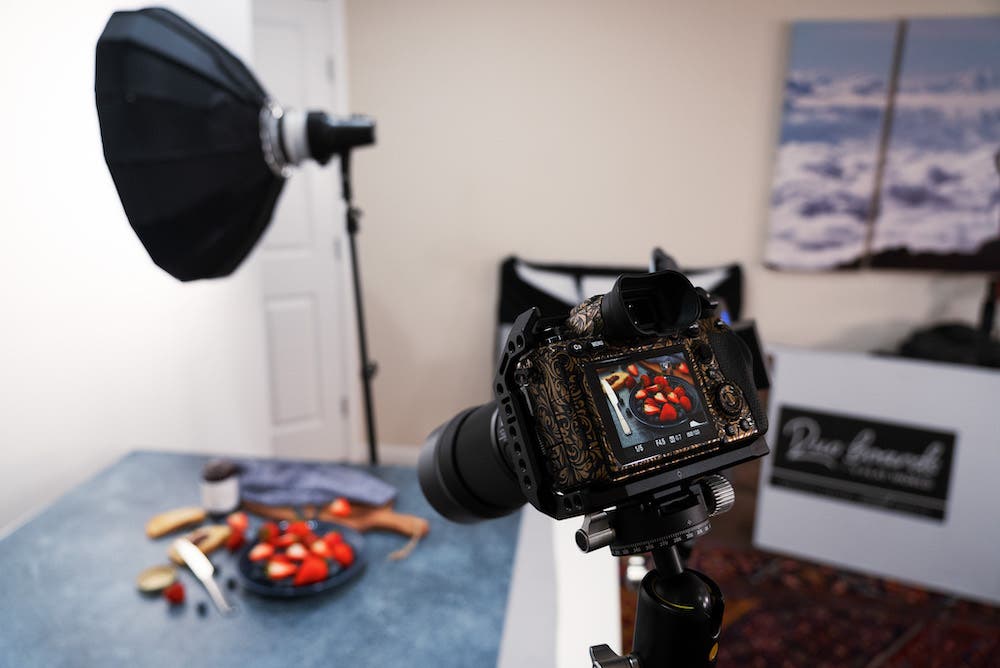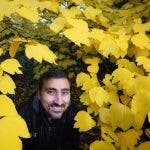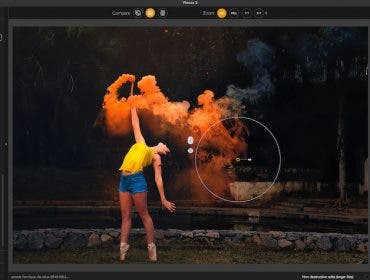Setting up for perfect food photography has its own recipe for success. Choosing the best lenses, picking the most attractive angles, and deciding on the perfect style are all important considerations for creating appetizing food photos.
In this guide, we’ll cover some helpful strategies for how to approach these considerations, and share some useful techniques and suggestions for how to set up for food photography.
Creating Mood And Ambiance Through Lighting
Lighting can dramatically change the mood of a photo. Through a small change in the angle, position, and intensity of the light, you can make a big impact. Diffused natural light is a great option for lighting. It can create soft and pleasing shadows in your images. Although, using off-camera lighting can give you more control over the exact look of the images.

What You See is What You Get with Continuous Light
Using continuous lighting for food photography is a convenient way to see the exposure of your final image as you’re creating it. Similar to how mirrorless cameras revolutionized the way we capture a photo with an electronic viewfinder, using continuous lighting to expose an image allows us to see the results of our lighting in real-time. Two great options for continuous lights that I use are the Light & Motion Stella Pro 8000 and the Adorama CLAR Slim 10″ Round Bi-Color LED Studio Light.

Thoughtful Compositions for Mouthwatering Food Photography
It is also important to choose the correct composition for the type of food that you’re planning to photograph. Choosing the best composition for your subject will help to show its most appealing angle. Think about the elements of the food in question. Experiment with classic food photography angles like “flay-lay” (overhead shots at 90 degrees), “straight-on” (or zero degrees), and any other creative angle between 25 and 75 degrees. You won’t want to shoot a juicy burger overhead since that would mainly show the bun, and miss all of the layers and juicy details that a zero-degree straight-on shot would provide. Try to compose food the same way you would any other subject. Shoot it at the best angle for the type of food that it is. Look to capture the most appetizing angle for your viewer.

Using V-Flat World Duo-Boards for Style and Texture
In addition to lighting and composition, another important factor that contributes to the appeal of your food photography is the surface that its captured on. I like to use reversible and textured surfaces from V-Flat World, called Duo-Boards. They come in a variety of sizes, colors, and textures, and are an essential component to set up for food photography. Mixing and matching them is a great way to create various looks that can give you the exact ambiance that you’re trying to create. They are also great for product photography, so definitely consider incorporating them into your setup.

Using a Tripod for Sharp Images and Long Exposures
Deciding on the best angle and composition for your food photography can be challenging. Using a dual approach to finding your favorite angle is ideal, especially when you’re unsure of the best view of the food. Begin by shooting your camera free-hand. Experiment with different angles and compositions. This will allow you the freedom to take some test images. It also allows you to decide on which angles you like most.
Once you’ve decided on the angles that you’d like to capture, incorporate a solid tripod into your setup. Using a solid tripod will ensure that you get the sharpest possible images, since you’ll avoid any camera shake. It also provides the added benefit of having access to longer exposures than what you normally achieve by shooting hand-held.

Being able to shoot long exposures with a tripod also allows you to shoot at your camera’s base ISO value. This gives you the maximum dynamic range in post-production. It also allows you to shoot with narrower apertures in lower dynamic lighting, without having to crank your ISO values too high to compensate. I like to use the Vanguard VEO 3T+ 264CB tripod. I highly recommend it as a solid and versatile tripod for food photography.

Pairing the Ideal Camera and Lenses
Setting up for food photography using different camera and lens combinations is another fun and important part of the process. One of the best things you can do to create appealing food photos is to shoot with varying levels of depth and focal lengths. I like to combine a good mix of zoom and prime lenses to tell a diverse visual story from different perspectives.

Fast aperture primes like the Sony FE 50mm f/1.2 G Master allow for a lot of depth control. A standard zoom lenses, like the Sony FE 24-105mm f/4 G OSS, allow me to experiment with a wide range of focal lengths.
To add additional flexibility, I like to use a high resolution camera like the 50-megapixel Sony Alpha A1. Using a high-resolution camera for food photography gives me the ability to crop and re-compose my images in post. This is a great way to showcase multiple perspectives without losing quality from cropping.

Lastly, I try to mix in a macro lens when possible. Macro lenses are super helpful, since they allow me to get super close to the details of the food. It can also compress the field of view, bringing all of the elements of a scene closer together. I personally use the Sigma 105MM F2.8 DG DN Macro Art, and love how it can magnify the elements I’m looking to capture in a scene.
Final Thoughts
Using these tips and techniques will help to get you set up for a fun and enjoyable food photography experience. Give them a try and check out our other articles on how to take your food photography to the next level:






